 The Imperial Treasury at the Hofburg Palace in Vienna is home to an extraordinary collection of treasures accumulated by the House of Habsburg over hundreds of years. Jewels, vessels made of gold, silver and gemstones, furniture, paintings, the imperial regalia of the Holy Roman Empire and opulent vestments are on display in the Secular Treasury, including one of my favorite historic textiles of all time, the Mantle of Roger II, made in 1133-4 for the Norman king of Sicily. The crimson samite mantle was embroidered in gold by Arabic craftsmen in Palermo who created a breathtaking split scene of lions attacking dromedaries on both sides of a stylized date palm. It made its way to the Holy Roman Empire through marriage by the early 13th century and to Vienna in 1801.
The Imperial Treasury at the Hofburg Palace in Vienna is home to an extraordinary collection of treasures accumulated by the House of Habsburg over hundreds of years. Jewels, vessels made of gold, silver and gemstones, furniture, paintings, the imperial regalia of the Holy Roman Empire and opulent vestments are on display in the Secular Treasury, including one of my favorite historic textiles of all time, the Mantle of Roger II, made in 1133-4 for the Norman king of Sicily. The crimson samite mantle was embroidered in gold by Arabic craftsmen in Palermo who created a breathtaking split scene of lions attacking dromedaries on both sides of a stylized date palm. It made its way to the Holy Roman Empire through marriage by the early 13th century and to Vienna in 1801.
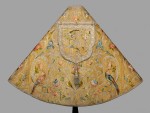 The Ecclesiastical Treasury features chalices, relics, monstrances, tabernacles and liturgical vestments. Its collection of 18th century religious textiles, most of which were donated to the Church by Emperor Charles VI, his wife Elisabeth Christine and their Empress Maria Theresa, mother of Marie Antoinette of France. The vestments were made of the most expensive French and Italian silks and satins that were then lavishly embroidered.
The Ecclesiastical Treasury features chalices, relics, monstrances, tabernacles and liturgical vestments. Its collection of 18th century religious textiles, most of which were donated to the Church by Emperor Charles VI, his wife Elisabeth Christine and their Empress Maria Theresa, mother of Marie Antoinette of France. The vestments were made of the most expensive French and Italian silks and satins that were then lavishly embroidered.
The extensive holdings of the Ecclesiastical Treasury in Vienna are largely unknown to the general public; they comprise mainly vestments and liturgical textiles that were used to celebrate Mass or during religious festivities. Totalling around 1,700 artefacts, the collection includes both sets of vestments and individual textiles. Many of these precious garments were donated by members of the House of Habsburg who for centuries ruled the Holy Roman Empire. The pomp and circumstance associated with this high office is reflected in the costliness of these sumptuous textiles, the finest of which date from the Baroque, the apogee of Habsburg piety. Unlike mediaeval ecclesiastical textiles, baroque vestments generally feature not figurative but purely ornamental decorations. Precious secular silks adorned with a variety of designs frequently function as the base material, which is then elaborately embellished with appliqués, lace or gold-, silver- and silk embroidery to produce opulent textile works of art.
The leading benefactress in the 18th century was Maria Theresia (1717-1780). She donated precious textiles for use in the imperial palace chapel and the chapels of the different imperial summer residences at Schönbrunn, Laxenburg and Hetzendorf, as well as in St. Augustine’s church in Vienna. The latter evolved into a major stage for Habsburg piety. Here newly-appointed bishops were invested. All these places were lavishly appointed with sumptuous ecclesiastical textiles.
These textiles are so fragile they are kept in conservation cabinets and cannot be on permanent display. Select pieces can be seen now in the special exhibition Praise of God, and the embroidery alone is mind-blowing.
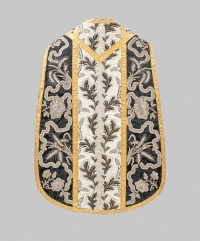
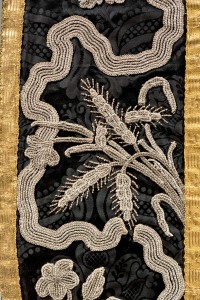
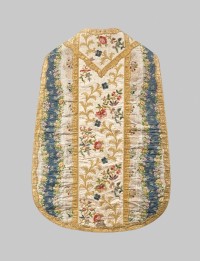
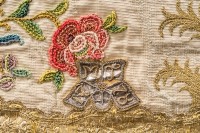
My Imperial favourite is the blue-coloured ‘star-spangled mantle‘ of of Henry II (HRR, b. 973 AD) in the Bamberg Cathedral museum.
Henry II’s involvement in Italian politics and his coronation as Emperor inevitably brought him into conflict with the Byzantine Empire. In 1017, aided by Norman mercenaries, Lombard noble Melus of Bari (referred to on the mantle as ‘Ismahel’, giving order to make it shortly after 1018) led a successful rebellion against Byzantine control of Apulia. The Byzantines struck back in 1018, represented by the ‘Katepan’ of Italy, a certain Βασίλειος Βοϊωάννης, delivering a defeat to the joint Lombard-Norman force at the Battle of Cannae.
Meeting Henry II in Bamberg, the Pope was accompanied by a large number of Italian secular and ecclesiastical leaders, including Melus. Henry II granted Melus the empty title Duke of Apulia for his actions against the Byzantines. But Melus died just a few days later, on April 23, 1020. He was given a lavish funeral and an ornate tomb in the new Bamberg Cathedral. After settling controversies with the bishops of Mainz and Würzburg, the Pope convinced Henry II to return to Italy for a third campaign to counter the growing power of the Byzantines.
Good argument can be made that the figures on the mantle of Roger II symbolize “defenders of the faith” having at the enemy du jour during the crusades.
Gorgeous mantles from the Bamberg Cathedral. 🙂 (Henry’s and Kunigunde’s)
As a person with embroidery as a hobby I always find stuff like this creatively fantastic. I wish the museum had more high-resolution photos of more of it but they do not. (Where do you get them from?)
Just a comment, that back then it is almost just as likely for those to have been stitched by men as women. Back then, the cash for the commission was reason enough for men to feel that textiles as a career (no more twist!) was not “too girly” for their machismo. (The Tailor of Gloucester by Beatrix Potter example) In a previous post (here) you mentioned a WW1 soldiers altar cloth on display in the UK that was done by men, there are also examples of stitching done by sailors in previous centuries aside their whalebone carving masterpieces.
As someone who embroiders ecclesiastical and liturgical items, these items are indeed mind-blowing!
Those mantles in Bamberg I saw live and in color, but also Gunther’s shroud (a Byzantine tapestry silk cloth), and there is an overview with at least a tiny selection of higher resolved pics (w/ silver embroidery !).
If anyone is interested in the history and social details of of ecclesiastical garments I can recomend the book ‘High Fashion in the Church by Pauline Johnstone’…..unfortunately the photographs are mostly Black and White but the text is very good.
In England the ‘guilds’ were always headed and mostly populated by men, that’s not to say that women were not very involved but the civilian workshops were usually family businesses handed down generation after generation, inter marrying with other ‘Brodery families’ to keep the trade secrets, as the heads of the families were men they were the one’s who got all the credit and official contracts/postings and their names on archive material.
Interestingly this elaborate type of silk and metal thread embroidery was usually ordered from commercial embroiderers while the ‘white-work’, hand made laces and embroidered linens were mostly done in the convents.
And of course the most famous object in the Hofburg is the Spear of Longinus, otherwise known as “The Spear of Destiny” as the book was titled.